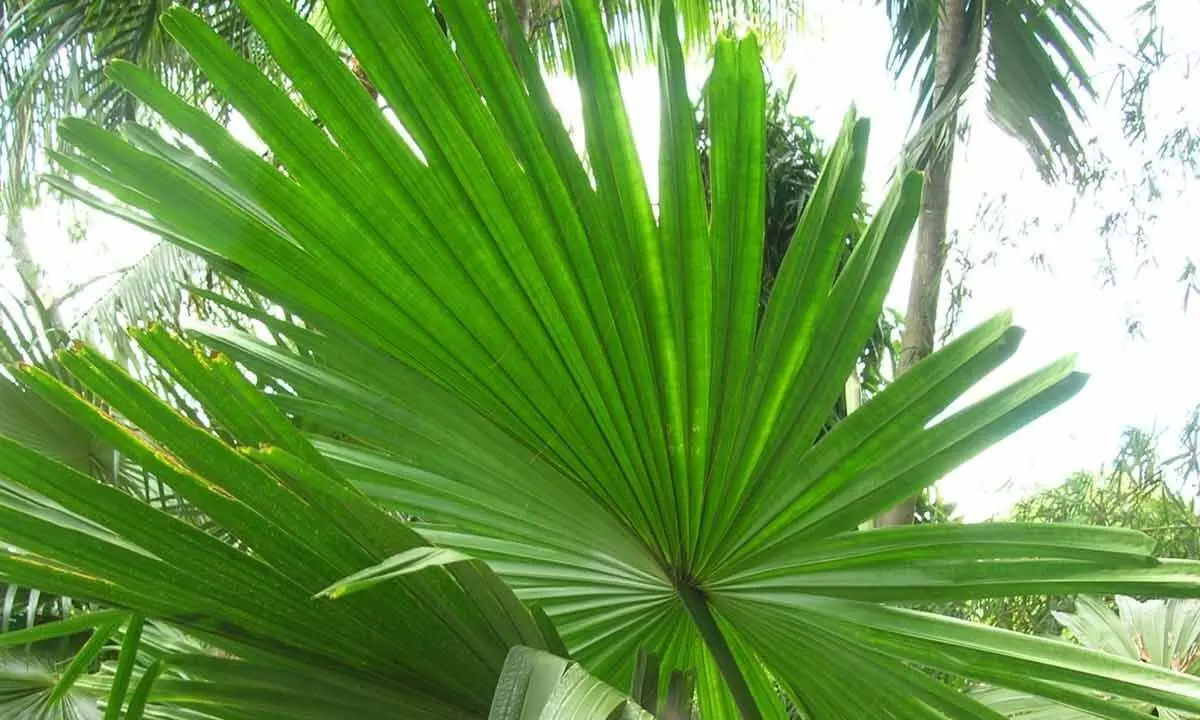'Srithale,' an ancient tree, is now saved from extinction

‘Srithale,’ an ancient tree, is now saved from extinction
This tree - Corypha umbraculifera - is seen as a wild growth in Tamil Nadu, Kerala, Andhra Pradesh, Telangana, Odisha and West Bengal and during the growth of Buddhism, it also went into South-Eastern countries. It has a unique type of leaf and when treated with a mixture of herbs they become extremely long-lasting
They say in Greek mythology a bird – Phoenix - had risen from the ashes of its predecessors. But the next generation will know another such incident in our own times about a timeless tree that has been saved from the extinction. Thanks to the efforts of one man Prof. SA Krishnaiah, one of the country's top researchers and palmleaf expert, the Srithale (Corypha umbraculifera) is on the revival path. Prof. S A Krishnaiah is the director of the Prachya Sanchaya (oriental archives) Research Centre based at Udupi.
This revival became more prominent as the seeds of the ancient tree was dispersed among the representatives of the All India conference of the traditional medical practitioners and the heads of the various religious institutions which was held in Kolhapur on February 24 . The conference was attended by Chief ministers of ten states, many Union Ministers, swamijis and pitadhipathis of many mutts of the five southern states.
The specialists attending the conference evinced keen interest in the qualities of the special tree. Swamiji of the Moodbidri Jain Mutt- Charukirthi Bhattaraka Panditacharyavarya has taken special interest in taking the seeds and seedlings of the trees to the conference and spread awareness about it among the delegates.
The traditional medical practitioners two day all India conference under the aegis of the 'Paramparika Vaidya Parishat at Koneri mutt is also examining the medicinal properties of the Srithale tree which has been sent to the conference by Prof. Krishnaiah.
In the last 18 months or so Krishnaiah has initiated seed dispersion of this tree to over a lakh individuals, groups of people and institutions all over the country from the banks of Cauvery to Godavari and Ganga and into the Kashmir valley.
He took up a campaign in 2018 to disperse seeds of 'Srithale' (Corypha umbraculifera) As he said "Originally we had planned to disperse the seeds of Srithale between Cauvery to the Godavari, but the encouragement we received from the conservationists, researchers and green activists was so overwhelming that we stretched our resources to reach Varanasi". Srithale also grows wildly in Tamil Nadu, Kerala, Andhra Pradesh, Telangana, Odisha and West Bengal and during the growth of Buddhism, it also went into South-Eastern countries.
The earliest mention of Srithale is however found in 'Upakathas' of the epic Ramayana. "Tamil Nadu even today holds the largest numbers of Srithale trees which number at 12,000. What is more important is that Srithale has a unique type of leaf. When treated with a mixture of herbs they become extremely long-lasting. The original manuscripts Kautilya's (Vishnu Gupta) 'Arthashastra' which is engraved on Srithale leaves dating back to 314 BC is still preserved in Oriental Institute of Research (ORI)in Mysuru. I do not think any modern storage devices or instruments will last that long. So if we are serious about saving the art of palm leaf engraving, conservation and protection of Srithale tree gains prominence" Krishnaiah says.
This heroic initiative of Prof. Krishnaiah has also saved the art and practice of Palm leaf inscriptions (palm leaf engraving) from extinction. "This is a species of palm- native to eastern and southern India and Sri Lanka. It is also grown in Cambodia, Myanmar, China, Thailand and the Andaman Islands. It is a flowering plant with the largest inflorescence in the world. But due to some superstitions numbers in India particularly on the Coast of Karnataka, these trees are cut down once they flower. The superstition is woven around an unfounded story that a flowering Srithale tree carries a bad omen, and the event of flowering will be followed by the death of an important elder belonging to the immediate vicinity of the tree.


















